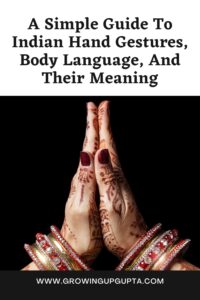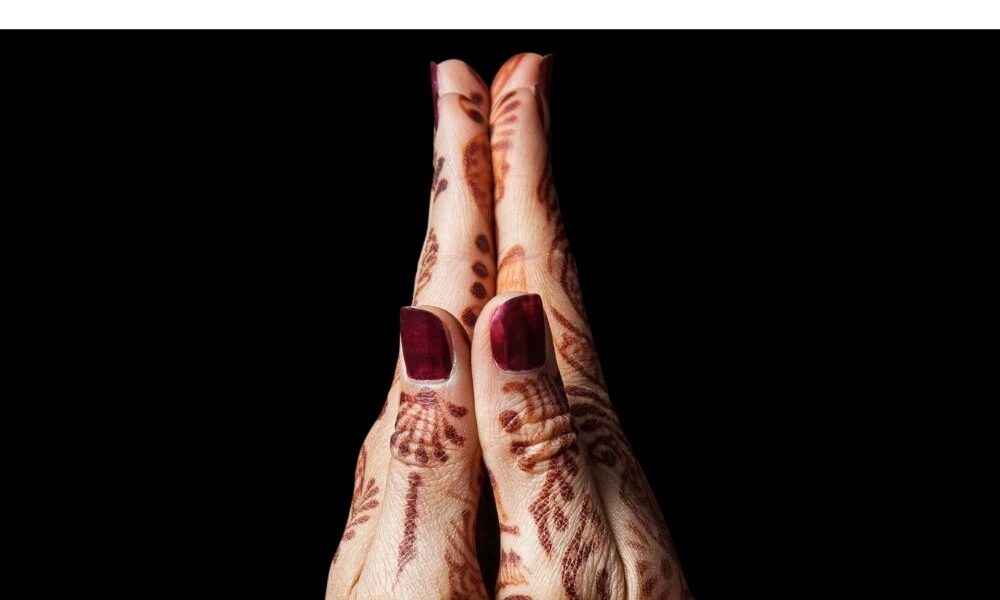A Simple Guide To Indian Hand Gestures, Body Language, And Their Meaning
Generally speaking, humans have two main methods of communication. These are verbal and non-verbal. Non-verbal communication makes up an immense part of our everyday lives. This form of communication involves using one’s hands and body to convey information or communicate with one another. For this reason, it is vital to learn and understand the art of body language and hand gestures.
Body language and hand gestures are practical tools that we can use to decode or interpret someone’s mood or mental state at a certain period. All the countries around the globe have some forms of body language and hand gestures that are peculiar to them. That is why a particular gesture in your home country may mean something entirely different when you visit another country. These differences are what give the concept of non-verbal interaction its uniqueness.
This article discusses the ancient gestures in India and their meanings. In the end, you will find it easy to decode and understand the hand gestures and body language whenever you visit India or during a conversation with an Indian/South Asian person.
Importance Of Indian Hand Gestures And Body Language
The Indian culture is one of the richest and most diverse in the world. Hand gestures and body language are popular ways Indians/South Asian people express their sense of emotion. These emotions include excitement, sadness, joy, disappointment, and many more.
They rely on several gestures for emotional expression. Gestures reflect their state of mind and make up an enormous part of their culture. For instance, if an Indian/South Asian person is having a conversation with you and wants to know if you are following the discussion or not, body language happens to be a perfect way to find an answer.
Why It Is Important To Understand Indian Hand Gestures And Body Language
There are some distinctive gestures and body language in India that you may find difficult to understand as a non-Indian, visitor, or tourist. Indian gestures are loud, open, and very expressive.
If you visit India, you will witness a wide array of gestures and body language among people, especially during conversations. If you are not familiar with these physical gestures, you may find it challenging to understand what they truly mean/intend to denote. Hence, it may become frustrating to interact with people, make friends, possibly offend someone or even get offended.
Popular Hand Gestures And Body Language
Below are some of the customary hand gestures and body language that Indian/South Asian people practice.
• Namaste Or Vanakkam
This greeting involves the joining of both hands. Here, you will have to put your palms together, place them in front of you, and say the word “Namaste” with a slight bow.
The word Namaste or Vanakkam (in Tamil) is not casually spoken. On the contrary, it is always exclaimed in great excitement, which can be noticed through the beautiful and gentle smile on the people’s faces as they say it. The hands, coupled with the word, are signs of respect, dignity, and acceptance while welcoming or receiving someone, saying hello, and praying to God at religious gatherings.
If you visit India, or whenever you are welcomed with this gesture, do not hesitate to reciprocate. In most parts of the world, this gesture has a different meaning. It is seen as an attempt to beg for something or ask for forgiveness.
• Touching The Feet Of Elderly People
This action signifies respect and gratitude in Indian culture. It is popular and widely practiced by younger individuals seeking the blessings of older adults in the family or community. It is also used in a situation where saying “Namaste” casually wouldn’t be appropriate.
For instance, if you see your parents, grandparents, or older relatives for the first time after being away for a very long time. This gesture is one of the numerous ways you can make them smile, feel special, and even melt their hearts. As a show of acknowledgment, an elder touches the head of the younger individual while they give their blessings. Sometimes, this gesture may be followed up with a phrase in India, wishing the younger individual a long and fulfilling life.
If you visit India, and a child or younger individual runs towards you and touches your feet, now you know what the gesture means and what you need to do in return. Also, if you find yourself in the position whereby you are the one touching the feet of an elder, do not perform this gesture hurriedly. Exercise patience by waiting for a few seconds to give the older adult enough time and space to bless you. This gesture won’t be complete without receiving their blessings. When you look at it from another perspective, it is more of a ritual than a gesture.
• Forming A Circle With The Tips Of The Index Finger And The Thumb
If you have seen this motion before and don’t clearly understand what it is all about, now is the time to understand what it means. This gesture is an indication of astonishment and excitement.
Suppose someone relates or communicates with you by using this gesture while having a conversation. In this case, it means such an individual really finds what you are saying fascinating, which may have resulted in a WOW experience. Instead of saying words like “fascinating, interesting, exceptional, and many other related words, an Indian/South Asian person may use this signal instead. In Hindi, this action is also known as Vaah!
• Hugging
Hugging is one of the most affectionate and heart-warming body language in Indian culture.
This gesture is a common practice among friends and cousins of the same age group and gender. Also, elders display love and affection towards their children and grandchildren by hugging them. This gesture is also common during festivals such as Eid and Holi.
All being said, there is an important tip you need to understand and always remember about hugging. No matter what the occasion is all about, or the traditions surrounding it, it is advised that you do not hug someone of the opposite sex as it is frowned upon.
• Nodding
Nodding is one of the most confusing physical gestures you will experience when you visit India as a tourist. It involves the subtle up and down movement of the head, and sometimes diagonally. In India, nodding is seen as a sign of acknowledgment, empathy, approval, or acceptance during a conversation.
For instance, an Indian/South Asian person may nod and shake their head in place of saying words like “Yes, that’s fine, okay,” etc. This habit is culturally embedded/comes naturally, and this is precisely why it is considered very powerful. If you decide to use this gesture, make sure to maintain eye contact to build trust.
• Pointing And Touching Things With Your Feet
While sliding the door and pointing at something with your foot is acceptable or considered normal in most parts of the world, it is seen differently in India. This approach or act is deemed to be offensive. Instead, if you want to slide or shut the door, the appropriate way to do this is to use your hand. The same applies when you need to point at things that interest you, which you may decide to share with other people. You don’t point with your foot; you can only point using your finger.
Just like the use of your left hand is forbidden (as it is considered unclean), the same belief is attached to the use of your foot for things that can be better presented or handled with your hand or finger. According to Indian culture and tradition, using your feet for any form of activity is considered inappropriate. Aside from playing football with your feet, when you visit India, ensure you steer clear of touching anything with them to avoid offending several people.
• Shaking Of The Head
This gesture denotes rejection or disapproval. It involves the shaking of the head sideways at a rapid rate. Suppose you have no understanding of this gesture before witnessing it. In this case, you may think the person communicating using this gesture is suffering from a seizure.
Frankly, this gesture may be disturbing to watch as it appears as if the individual’s neck will break. Once you have a clear understanding of what this means, you will accept it for what it is and realize that the person is completely fine.
An Indian/South Asian person may shake their head as a sign of a negative remark or response instead of saying words like “I don’t know, or No, I don’t have an idea,” etc.
• The Consistent Use Of The Right Hand
The consistent use of the right hand is one of the most popular traditions in India. Every Indian/South Asian person is expected to use their right hand for everything they do. According to popular belief, this brings about prosperity and good fortune.
People are not encouraged to use their left hand while performing or engaging in any activity because it is widely regarded or considered filthy and profane. Hence, the right hand is used predominantly, especially during meals and while handling and exchanging money. This belief is also associated with the feet. For instance, if you are moving into a new house or visiting someone who has just moved into a new home. You are expected to enter the building with your right foot then followed by your left foot. In the Indian culture, this is believed to usher in luck and good tidings. This action is not simply a random practice; it is mandatory.
You may have witnessed this act in Bollywood movies or personally. An Indian/South Asian person will shake you using their right hand during a conversation and place the left hand on your shoulder or on your left hand. You can never see this happen in the opposite manner. If you do not understand what this gesture means, it is a declaration of assurance and confidence. Now that you know how important the right hand is in Indian culture make sure you embrace the tradition when you visit India, especially if you have a habit of handling things mostly with your left hand.
• Receiving Holy Offerings In Your Hand
The holy offerings are known as Prasad in Hindi. If you visit India and go to a place of worship or temple, you may be offered a sacred gift. This gift is usually something sweet that you can eat once the prayer comes to an end.
You are expected to accept the sacred gift or offering in a certain manner. There is a specific gesture associated with how you receive the sweet edible when offered. Join your hands sideways, with your palms facing the sky or upward direction as if you are asking or requesting something. In some situations, you may be required to pick up the sacred offering yourself. As discussed earlier, ensure you pick it up using your right hand.
Was this simple guide useful? What did you think about this simple guide to Indian Hand Gestures, Body Language, And Their Meaning. Do you have any to add to this list? Comment below! Please write to us @[email protected]!
Pin this post for later, here!

Are you following us at www.growingupgupta.com yet? Find us on Instagram and Pinterest @growingupguptas and on Twitter @growingupgupta, Facebook @growingupguptablog.
This post contains affiliate links that support the operation of this blog!


























